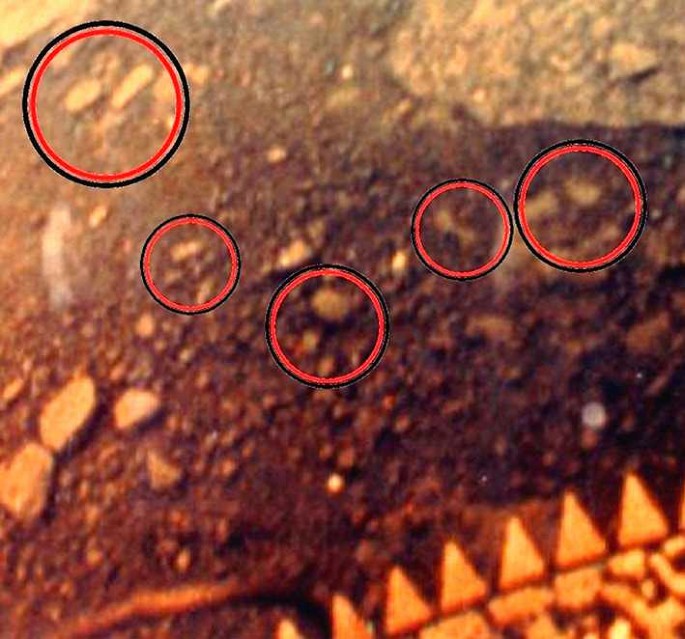Alas for Thompson & West, this wondrous blast from the past did not long survive peer review. The purported alien shrapnel proved to be bits of terrestrial magnetite- the stuff of lodestones, the cosmic tuskers having overlooked the geological ubiquity of iron.
With so much magnetite underfoot- it's the black sand that clogs gold prospector's pans in Alaska, mammoths rooted about at far greater risk of getting bits stuck in their ivories than being whacked by meteorites.
But after a long nap
THE COSMIC TUSK HAS AWAKENED :
The sciency internet is alive with consensus condemnation and universal damnation for a new paper from Rhawn Joseph, now dubbed the “Tiger King of Mars.” In the article below, Joseph et al. continues a radical break from conventional interpretations of Martian photography, believing a number of odd features photographed by the Martian rovers are…wait for it…mushrooms and fungi.
The Tusk has seen so much mistreatment and knee jerk criticism of the Younger Dryas Impact Hypothesis, (an order of magnitude less heretical science), I feel some empathy for the poor guy — right or wrong. It’s so sad the press can’t find time to give him — or his co-authors — a telephone call before tearing his ass off on-line as a fraud.
I don’t think he is fraud, or a hoaxter. Probably wrong, surely iconoclastic, but Rhawn Joseph in my distant estimation sincerely believes every word he writes. And personally I find his paper well-written and worthy of somewhat thoughtful criticism and refutation, not ad hominem attacks.
While it is very hard to believe NASA has missed mushrooms on Mars, it sure would be nice if they would take one of those robo tools and give a Martian hematite sphere a little “poke” — just to see if it’s puffy — or squishy."
Fungi on Mars?
Evidence of Growth and Behavior From Sequential Images
Fungi thrive in radiation intense environments. Sequential photos document that fungus-like Martian specimens emerge from the soil and increase in size, including those resembling puffballs (Basidiomycota).
After obliteration of spherical specimens by the rover wheels, new sphericals--some with stalks--appeared atop the crests of old tracks. Sequences document that thousands of black arctic "araneiforms" grow up to 300 meters in the Spring and disappear by Winter; a pattern repeated each Spring and which may represent massive colonies of black fungi, mould, lichens, algae, methanogens and sulfur reducing species. Black fungi-bacteria-like specimens also appeared atop the rovers. In a series of photographs over three days (Sols) white amorphous specimens within a crevice changed shape and location then disappeared. White protoplasmic-mycelium-like-tendrils with fruiting-body-like appendages form networks upon and above the surface; or increase in mass as documented by sequential photographs. Hundreds of dimpled donut-shaped "mushroom-like" formations approximately 1mm in size are adjacent or attached to these mycelium-like complexes.
Additional sequences document that white amorphous masses beneath rock-shelters increase in mass, number, or disappear and that similar white-fungus-like specimens appeared inside an open rover compartment. Comparative statistical analysis of a sample of 9 spherical specimens believed to be fungal "puffballs" photographed on Sol 1145 and 12 specimens that emerged from beneath the soil on Sol 1148 confirmed the nine grew significantly closer together as their diameters expanded and some showed evidence of movement. Cluster analysis and a paired sample 't' test indicates a statistically significant size increase in the average size ratio over all comparisons between and within groups (P = 0.011). Statistical comparisons indicates that arctic "araneiforms" significantly increased in length in parallel following an initial growth spurt. Although similarities in morphology are not proof of life, growth, movement, and changes in shape and location constitute behavior and support the hypothesis there is life on Mars.
CNET, “No, NASA photos are not evidence of fungus growing on Mars, sorry,” May 6, 2021
TNW News, “Mushrooms on Mars is a hoax — stop believing hack ‘scientists,’” May 7, 2021
READERS SHOULD NOTE THAT JOSEPH'S 2019 REPORT OF TRUFFLES ON VENUS PROVED PERISHABLE AS WELL :
RETRACTED ARTICLE:
Life on Venus and the interplanetary transfer of biota from Earth
Astrophysics and Space Science 364, Article number: 191 (2019)
Abstract
Evidence and observations favoring the hypothesis that Venus is habitable, and the celestial mechanisms promoting the interplanetary transfer of life, are reviewed. Venus may have been contaminated with Earthly life early in its history via interplanetary transfer of microbe-laden bolide ejecta; and this seeding with life may have continued into the present via spacecraft and due to radiation pressure and galactic winds blowing microbial-laden dust ejected from the stratosphere via powerful solar winds, into the orbit and atmosphere of Venus. Venus may have had oceans and rivers early in its history until 750 mya, and, hypothetically, some of those species which, theoretically, colonized the planet during that time, may have adapted and evolved when those oceans evaporated and temperatures rose. Venus may be inhabited by a variety of extremophiles which could flourish within the lower cloud layers, whereas others may dwell 10 m below the surface where temperature may be as low as 200 ∘C—which is within the tolerance level of some hyperthermophiles. Speculation as to the identity of mushroom-shaped specimens photographed on the surface of Venus by the Russian probe, Venera 13 support these hypotheses.
Overview: hypotheses, observations, evidence
Observations and evidence for the possibility of life on the subsurface and clouds of Venus, and celestial mechanics promoting the transfer of life from Earth, are reviewed, and images of specimens resembling fungal mushroom-shaped organisms photographed by the Russian Space Probe Venera 13, on the surface of Venus are presented (Figs. 1–5) with the caveat that similarities in morphology are not proof of life.




